9 Product Category Marketing Examples to Inspire Your Own
People want a sense of direction when they’re shopping. They want to see their choices grouped together — whether they’re looking for spoons, granola, or winter coats. Brands make this happen with the product category.
Product category marketing helps your brand stand out among related items, so your company’s products wind up in the shopping cart.
Let’s explore product categories and see some examples in action. Continue reading or jump to the section you’re looking for:
- What is a product category?
- Examples of Product Categories
- What is product category marketing?
- Why Product Category Marketing Is Important
- Product Category Marketing Examples
Product categories are sometimes confused with product classification. Both are organizational strategies that help guide marketing decisions. But product classifications are much broader (think convenience goods, shopping goods, or specialty goods).
A product category can also improve the user experience. With clear product categories, products are easier for customers to find and understand. Product categorization is also useful for businesses to streamline processes and follow product regulations.
Examples of Product Categories
Your distinct products and customer personas should guide your product categories.
Some businesses use product categories that are broad and based on industry and competitor analysis. These companies may use product categories such as:
- Mobile phones
- Game consoles
- Household furniture
- Home appliances
- Clothing
For example, Dick’s Sporting Goods offers a variety of outdoor and sports gear. Top-level categories on their site include Sports, Outdoor, and Exercise and Wellness.
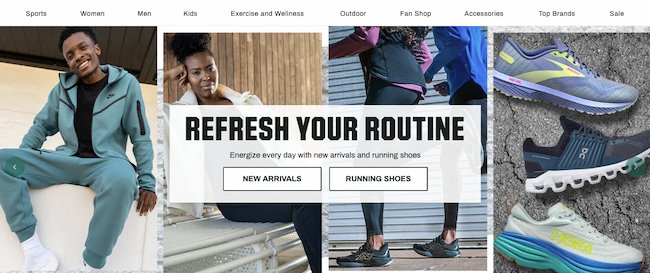
Then, it breaks each of these categories into interest-based categories. Categories within outdoor gear include:
- Snow Sports
- Camping & Hiking
- Yard Games
This company sells many types of products, so its website has several levels of categories before a user reaches products for sale. But as competition grows, a business may get more niche and target a specific consumer.
The cosmetics industry is competitive. Customers looking for cosmetics and skincare have many choices. So, the target audience needs product categories that let them quickly find exactly what they’re looking for.
For example, the skincare brand Dr. Jart+ offers product categories such as:
- Moisturizers
- Masks
- Exfoliators
- Serums
This company also organizes products on its website using customer concerns such as oily skin, blemish-prone, and dullness. These categories give users several ways to find the right product online.
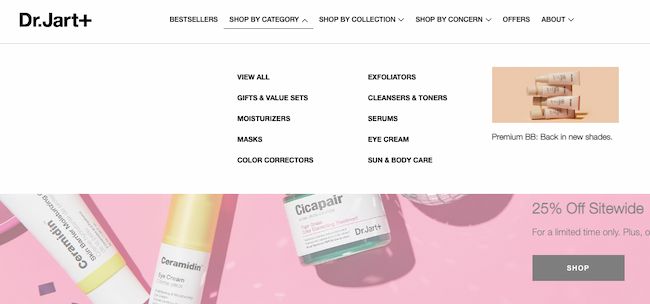
Businesses also categorize products using guidelines from the platforms they use to sell their items.
For example, platforms like Facebook, Shopify, and Google have standard product categories for sellers. Most also offer the choice of adding a custom category, but many new businesses use these product category choices as a guide.
Some companies promote individual products, but as a business grows they often shift to promoting groups of products. Marketing by category helps companies brand and promote that group of connected products.
Product category marketing amplifies why a company is the best choice within that group of products. It helps you explain why customers opt for your offering rather than your direct competitors.
Why Product Category Marketing Is Important
Product category marketing improves the customer experience.
Imagine shopping at a grocery store without any signs pointing you in the right direction. Odds are you’d spend a lot of time wandering the aisles until you found what you needed.
Using the right categories makes products easier to find and understand. Marketing for those categories helps businesses highlight how those products can ease customer pain points.
Product category marketing builds trust.
When consumers have positive experiences with a specific product category it also builds brand trust. This often expands to other categories through the halo effect.
Grouping products creates a larger pool of data to understand your customer buyer journey. This helps you meet expectations and build trust in your brand.
Product category marketing improves brand awareness.
It’s more effective to figure out a brand proposition for a group of products than for a single product. This approach can appeal to more customers and increase attention for your brand.
Product category marketing can increase leads and sales.
Gaining brand recognition and appreciation across a product category means greater returns for your efforts.
Product category marketing helps users spend more time with your products. It connects audiences to new products related to the ones they already love.
Product Category Marketing Examples
1. Fenty Beauty
Product category: Skincare
Admittedly, it helps to have singer and business powerhouse Rihanna at the helm. But Fenty Beauty innovated the idea of foundation makeup “for all.” Its commitment to inclusivity made the brand an instant hit.
Beyond foundation, the Fenty Beauty Face products include bronzer, highlighter, powder, and concealer in shades that work for everyone. The launch was an industry transformer.
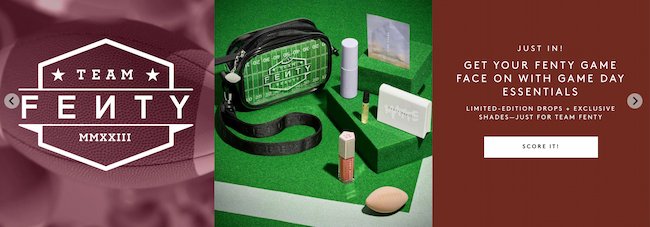
The next product category innovation falls under the brand Fenty Skin. Departing from other cosmetics approaches to skincare categorization, this brand includes product categories for fragrance, facial, and body care. It also has a campaign-specific product category, the Game Day collection that ties into Rihanna’s 2023 Super Bowl performance.
Why it works: Fenty’s success underlines a simple truth about today’s consumers: they are belief-driven. Increasingly, consumers want to see brands improve the world while making a profit. Fenty aligns with this shift by keeping diversity and inclusion top of mind with its product offerings — and by featuring models across a spectrum of skin tones.
2. Orvis
Product category: Dog beds
This Vermont-based retailer has been a big name in fly-fishing and outdoor gear since 1856. But they’ve also carved out a product niche with dog gear — and dog beds in particular. The brand draws people who want comfortable dog beds for their furry pals in styles that enhance their home decor.
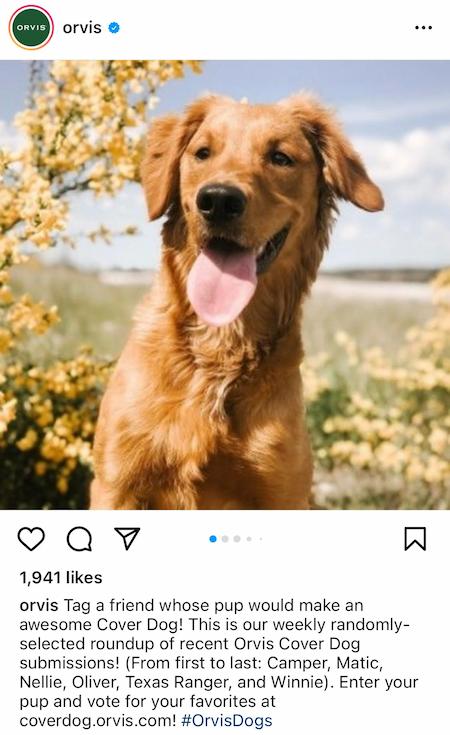
The marketing images of dogs sleeping or lounging on Orvis beds is enough to inspire a nap. And its social feeds are chock full of irresistible images and videos of dogs, including puppies in a hammock.
Why it works: The company has built a loyal following with the fundamental belief that pets are significant members of the family. Orvis has made its site a resource for dog health and behavior topics, and they boast a variety of dog beds for dogs of all sizes, ages, and health issues.
3. Ikea
Product category: Home textiles
Putting together its furniture may be a tough task, but at least Ikea supports your relaxation too. The marketing of their bedding shows off playful sheets and prints for kids — plus a mix of bold designs and neutrals for adults. The bed linen product category falls under ‘home textiles’ with curtains, quilts, pillows, and towels.

A recent Ikea ad campaign combined this product category with a multi-category collection celebrating the Lunar New Year. This move makes it easy to find practical items like gorgeous pillowcases. At the same time, it adds seasonality for shoppers who already have a home full of IKEA basics.
Why it works: By grouping a variety of products under one roof — the FÖSSTA collection — Ikea presents an opportunity to up-sell. After all, if you buy new bed sheets, you may also need new lamps, pillows, and placemats.
4. Swarovski
Product category: Jewelry
For more than a century, Swarovski has put the sparkle in gowns, tiaras, jewelry, sculptures, and even luxury cars. For its jewelry product category, Swarovski puts luxury within reach with a mix of modern and classic crystal necklaces, earrings, bracelets, and watches.

It sustains brand awareness with seasonal collections, collaborations with designers and celebrities, such as Karl Lagerfeld, Doja Cat, and Penelope Cruz, and social media campaigns with influencers.
The brand also partners with a range of other brands. For example, a collaboration with BMW features Swarovski crystals inside the headlights and running lights of their 7 Series G70 and X7 models.
Why it works: Swarovski has taken its medium, crystal, to new heights with creative partnerships and continued innovation. It’s these efforts that keep the brand — and its products — fresh and exciting even after 125 years in business.
5. Target
Product category: Grocery essentials
Target is known for its positioning across product categories, including affordable fashion, electronics, and cleaning supplies. Though their grocery section is smaller than most supermarkets, it covers all the ‘must-haves’ on any shopping list — from milk to salads to pasta.
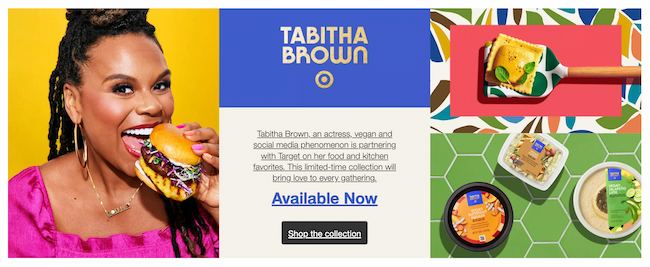
In 2023, Target’s focus is on one-stop shopping, with grocery product categories that highlight the range of products you can buy at Target. So, shoppers looking for grocery mainstays can also buy kitchen tools from their favorite food influencers.
Why it works: Target uses private labels and exclusive brands to its advantage. If you get hooked on a Target-exclusive product — like an item from their Good & Gather line — you can’t go anywhere else to buy it.
6. Dove
Product category: Skincare
Launched in 2004, Dove’s ‘Real Beauty’ campaign was far ahead of other brands in promoting body positivity and self-acceptance. Their recent ad campaigns challenge toxic beauty standards with confident messaging and a wide variety of body types and skin colors. With this in mind, product categories like “Skin Cleansing” and “Men + Care” emphasize self-care.

Rolls, wrinkles, cellulite, and stretch marks are all on proud and beautiful display across its social channels. Dove body lotions and soaps are also frequent fliers on “best of” lists for affordable skincare.
Why it works: In an industry that typically profits from consumers feeling unhappy with their appearance, Dove stands out with a marketing strategy that centers on building self-confidence. Dove energizes its brand with a higher purpose that most women — their target audience — can get behind.
7. Michaels
Product category: Holidays & Occasions
The company known for DIY is also a go-to spot for holiday and seasonal decorating. Michaels stores transform constantly with festive décor for each season plus Halloween, Thanksgiving, Hanukkah, Christmas, Independence Day, Pride Month, and more.
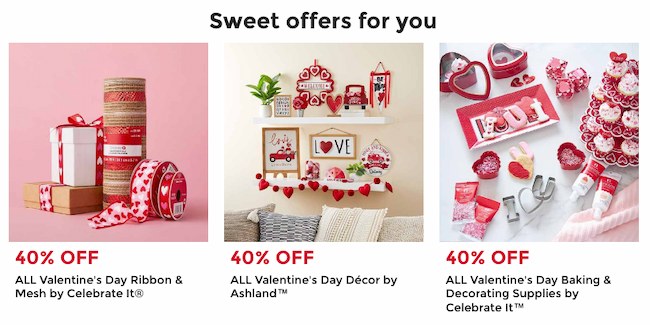
Michael’s also does an exceptional job engaging with the creative community. Most stores offer online and in-store classes, demos, and events that anyone can attend.
Why it works: Michael’s continues to find new ways to engage with new and existing customers — from festive in-store displays to free classes and demos. It positions itself as more than a supply store, but rather a source of fun and inspiration.
8. Patagonia
Product category: Eco-friendly outerwear
Patagonia’s brand purpose isn’t just about making the best product. The brand seeks to “Cause no unnecessary harm” and the company’s marketing efforts lead with its commitment to sustainability across product lines. Its website urges consumers to buy sustainably, with product categories like “Trade In, Get Credit,” and “Used Gear.”

When you visit its Facebook or Instagram pages, you have to hunt a bit to find posts highlighting particular products. Instead, the feeds focus on pressing issues, such as environmental stewardship and fair labor practices.
Why it works: Patagonia effectively weaves its core values into its marketing messages. When you do need to purchase a new (or used) piece of outerwear, consumers know they are supporting a company that actively minimizes its negative impacts.
9. Grove Collaborative
Product category: Green cleaning products
The company offers eco-friendly cleaning supplies, like soap and detergent refills and reusable glass bottles. It sends these products out in recurring monthly shipments.
The company uses product categories to highlight seasonal programs and initiatives. For example, the “New Year, No Plastic Waste” product category highlights products that can help consumers reduce their use of packaging and products that can help cut added plastic.
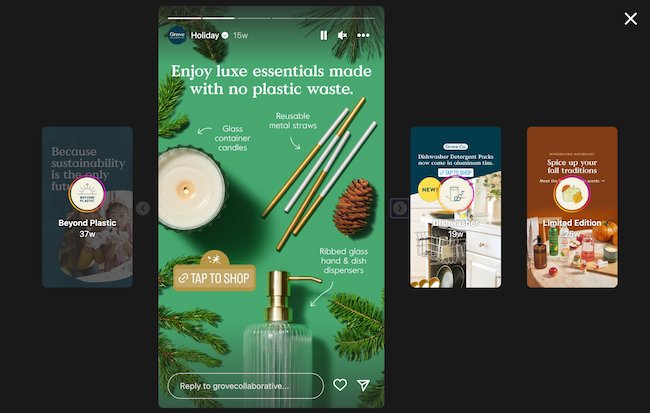
Why it works: The company’s marketing reflects its minimalist ethos. Grove also uses social media, namely Instagram Stories, to attract new customers with product images, cleaning tips, and funny videos.
Each of these brands has clarified where their products fit in larger retail categories. This helps them market their distinct value to target customers and, ultimately, earn a greater market share within their industries and niches.
How can the right product marketing category impact your business?
What consumers want changes every day, and those habits can bring dramatic changes to your business.
Choosing the right category can help you organize your products around what your target audience wants. They’re a simple way of sharing your brand values. And they make it easier for every website visitor to trust your knowledge and the quality of your products.
So, take a look at your product categories today. Think about how you can make them more useful and relevant to your customers. Then, find a way to use each product category to reach an even wider audience.
Editor’s note: This post was originally published in May 2021 and has been updated for comprehensiveness.
![]()


![→ Download Now: Free Product Marketing Kit [Free Templates]](https://no-cache.hubspot.com/cta/default/53/08b5e1f4-5d26-405b-b986-29c99bd0cb14.png)
